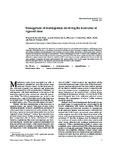1 - 25 of 10
| Creator | Title | Description | Subject | Date | ||
|---|---|---|---|---|---|---|
| 1 |
 |
Del Fiol, Guilherme | Providers' information needs in the care of older adults | 2013 Center on Aging Poster Retreat; Information needs; Clinical decision support; Electronic health record | 2013 | |
| 2 |
 |
Farrell, Timothy W. | The state of care transitions education: A survey of AGS teachers section members | Care transitions pose significant risks for older and more complex medical patients, including medication errors and rehospitalizations. Unfortunately, few medical schools and residency programs provide targeted care transitions training. Changes in the healthcare system, including coordination of c... | 2013 AGS Posters, AGS, care transitions, geriatrics education | 2013 |
| 3 |
 |
Mitchell, Joyce A. | Assessing clinical researchers information needs to create responsive portals and tools: my research assistant (MyRA) at the University of Utah: a case study | Question: How can health sciences librarians and biomedical informaticians offer relevant support to Clinical and Translational Science Award (CTSA) personnel? Setting: The Spencer S. Eccles Health Sciences Library and the associate vice president for information technology for the health sciences o... | 2013-01-01 | |
| 4 |
 |
Couldwell, William T. | Intracranial hypotension in the setting of concurrent perineural cyst rupture and subarachnoid hemorrhage | Although most patients with intracranial hypotension typically present with headaches, the rest of the clinical spectrum is characteristically non-specific and often quite variable. In a patient with concurrent pathologies that can produce a similar clinical picture, a high index of suspicion must b... | 2013-01-01 | |
| 5 |
 |
Couldwell, William T. | Management of meningiomas involving the transverse or sigmoid sinus | Meningiomas that invade the transverse or sigmoid sinuses are uncommon tumors that are challenging to treat surgically. Although the risk of recurrence is associated with the extent of resection, complete removal of meningiomas in these locations must be balanced with avoidance of venous outflow obs... | 2013-01-01 | |
| 6 |
 |
Couldwell, William T. | Pituitary models | Pituitary tumor animal models provide researchers a microenvironment that simulates the clinical situation; however, in comparison with astrocytoma and meningioma tumor research where intracranial xenograft transplantations are increasingly being used to test various therapeutic modalities, in vivo ... | 2013-01-01 | |
| 7 |
 |
Bernstein, Paul S. | Reflection-based imaging of macular pigment distributions in infants and children | We have developed a reflection-based capability of the RetCam® platform, an FDA-cleared pediatric retinal-imaging instrument, for the purpose of measuring macular pigment levels as well as their spatial distributions in infants and children. Our modifications include narrow-band blue-wavelength exc... | 2013-01-01 | |
| 8 |
 |
Couldwell, William T. | Role of CCM1 loss-of-function-induced endothelial-to-mesenchymal transition in the development of cavernous malformations | Cerebral cavernous malformations (CCM) occur in two variants: sporadic and familial. Mutations in three genes-CCM1, CCM2, and CCM3-play a role in both subtypes, with mouse models showing the development of multiple cavernous malformations in animals with loss of function in any of these three genes.... | 2013-01-01 | |
| 9 |
 |
Couldwell, William T. | Surgical fidelity: comparing the microscope and the endoscope | Background: Both the microscope and the endoscope are widely used as visualization tools in neurosurgery; however, surgical dexterity when operating with endoscopic visual control may differ. The aim of this study was to compare the surgical fidelity when using each of these visualization tools. Met... | 2013-01-01 | |
| 10 |
 |
Jensen, Randy Lynn | Treatment-related brain tumor imaging changes: so-called "pseudoprogression" vs. tumor progression: Review and future research opportunities | Background: Glioblastoma multiforme (GBM) has a dismal prognosis despite aggressive therapy. Initial diagnosis and measurement of response to treatment is usually determined by measurement of gadolinium-enhanced tumor volume with magnetic resonance imaging (MRI). Unfortunately, many GBM treatment mo... | 2013-01-01 |
1 - 25 of 10
